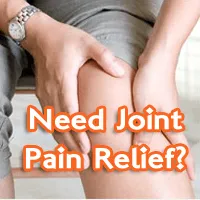Is joint pain holding you back? Perhaps an achy ankle or sore knee is making it difficult to enjoy a run through your favorite park or even a short walk? Or a throbbing hip or shoulder prevents you from driving a golf ball down the fairway or from performing simple tasks like carrying a bag of groceries into your home? Sharp reminders of your limitations arrive thick and fast, practically every time you move.

What causes Joint Pain?
Very often, the culprits behind joint pain are: osteoarthritis, old injuries, repetitive or overly forceful movements during sports or work, posture problems, aging, inactivity
How Exercise Can Help
Ignoring the pain won’t make it go away, nor will avoiding all motions that spark discomfort. In fact, limiting your movements can weaken muscles, compounding joint trouble, and affect your posture, setting off a cascade of further problems. And while pain relievers and cold or hot packs may offer quick relief, fixes like these are merely temporary.
By contrast, the right set of exercises can be a long-lasting way to tame ankle, knee, hip, or shoulder pain. Practiced regularly, joint pain relief workouts might permit you to postpone — or even avoid — surgery on a problem joint that has been worsening for years by strengthening key supportive muscles and restoring flexibility.
Over time, you may find limitations you’ve learned to work around will begin to ease. Tasks and opportunities for fun that have been weeded out of your repertoire by necessity may come back into reach, too.
Beyond the benefits to your joints, becoming more active can help you stay independent long into your later years. Regular activity is good for your heart and sharpens the mind. It nudges blood pressure down and morale up, eases stress, and shaves off unwanted pounds. Perhaps most importantly, it lessens your risk of dying prematurely. All of this can be achieved at a comfortable pace and very low cost in money or time.
Why Weight Matters
Being overweight raises your risk for developing osteoarthritis in a weight-bearing joint like the knee — and even in the hand, according to some research, since inflammatory factors related to weight might exacerbate this condition. Simply walking across level ground puts up to one-and-a-half times your body weight on your knees. That means a 200-pound man will deliver 300 pounds of pressure to his knee with each step.
Off level ground, the news is worse: Each knee bears two to three times your body weight when you go up and down stairs, and four to five times your body weight when you squat to tie a shoelace or pick up an item you dropped.
Fortunately, strengthening your quadriceps (the muscles on the fronts of the thighs) changes the equation, and so does losing weight. Each pound you lose reduces knee pressure in every step you take. One study found that the risk of developing osteoarthritis dropped 50 percent with each 11-pound weight loss among younger obese women.
If older men lost enough weight to shift from an obese classification to just overweight — that is, from a body mass index (BMI) of 30 or higher down to one that fell between 25 and 29.9 — the researchers estimated knee osteoarthritis would decrease by a fifth. For older women, that shift would cut knee osteoarthritis by a third.
– Harvard Health Letters
(C) 2012. PRESIDENT AND FELLOWS OF HARVARD COLLGE. ALL RIGHTS RESERVED DISTRIBUTED BY TRIBUNE MEDIA SERVICES, INC.
